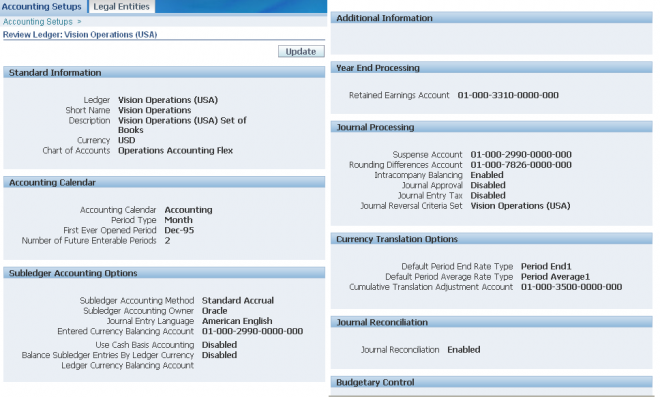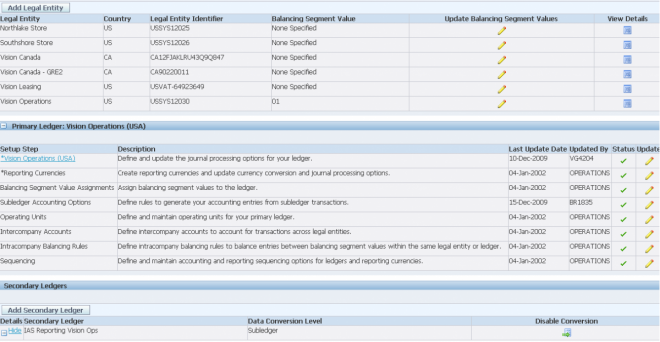Release R12 | Oracle ERP R12
Ledgers
A ledger determines the currency, chart of accounts, accounting calendar, ledger processing options and subledger accounting method, if used, for a legal entity, group of legal entities, or some other business purpose that does not involve legal entities.

- You define ledgers when you create accounting setups in Accounting Setup Manager.
- Each accounting setup requires a primary ledger and optionally one or more secondary ledgers and reporting currencies.

Types of Ledgers
There are two types of ledgers: primary and secondary.
Primary Ledger
The primary ledger acts as the main record-keeping ledger. If used for the purpose of maintaining transactions for one or more legal entities, it uses the legal entities' main chart of accounts, accounting calendar, currency, subledger accounting method, and ledger processing options to record and report on all of their financial transactions. If used for another business purpose where no legal entities are involved, then the primary ledger is defined with the chart of accounts, accounting calendar, and currency that is suited for the business need. One primary ledger is required for each accounting setup.
Secondary Ledger
The secondary ledger is an optional, additional ledger that is associated with the primary ledger for an accounting setup. Secondary ledgers can be used to represent your primary ledger's accounting data in another accounting representation that differs in one or more of the following from the primary ledger:
• Chart of accounts
• Accounting calendar/period type combination
• Currency
• Subledger accounting method
• Ledger processing options
Secondary ledgers can be used in many ways.
- For example, if a legal entity must perform corporate and statutory reporting, you can use the primary ledger to satisfy corporate reporting requirements and then use a secondary ledger to satisfy statutory reporting requirements.
- If a legal entity is a subsidiary of a parent company and must produce its financial results according to the parent company's reporting requirements in addition to its own local reporting requirements, then a secondary ledger may be used to satisfy the additional reporting requirement.
• Balance: The balance level secondary ledger maintains your primary ledger account balances in another accounting representation. This type of secondary ledger requires you to use Oracle General Ledger Consolidation to transfer your primary ledger balances to this secondary ledger.
• Subledger: The Subledger level secondary ledger maintains subledger journals, general ledger journal entries, and balances in the additional accounting representation. This data conversion level uses both Oracle Subledger Accounting and General Ledger Posting to create the necessary journals in both your primary and secondary ledgers simultaneously.• Journal: The journal level secondary ledger maintains your primary ledger journal entries and balances in an additional accounting representation. This type of secondary ledger is maintained using the General Ledger Posting Program. Every
time you post a journal in your primary ledger, the same journal can be automatically replicated and maintained in the secondary ledger for those journal sources and categories that are set up for this behavior.
• Adjustments Only: The Adjustments Only Secondary Ledger is an incomplete accounting representation that only holds adjustments. The adjustments can be manual adjustments or automated adjustments from Oracle Subledger Accounting.
This type of ledger must share the same chart of accounts, accounting calendar/period type combination, and currency as the associated primary ledger. To obtain a complete secondary accounting representation that includes both the transactional data and the adjustments, you must then combine the adjustments-only secondary ledger with the primary ledger when running reports.
Note: If you only need to represent your primary ledger transactions in another currency, you do not need to use secondary ledgers; you can use reporting currencies.
Reporting Currencies
If you want to maintain your ledger transactions in multiple currencies, you can use reporting currencies. Reporting currencies are additional currency representations of primary or secondary ledgers. Unlike secondary ledgers, reporting currencies can only differ by currency from their source ledger and must share the same chart of accounts, accounting calendar/period type combination, subledger accounting method, if used, and ledger processing options. Reporting currencies can be used for supplementary reporting purposes, such as consolidation or management reporting. They can also be used if you operate in countries with highly inflationary economies.
Reporting currencies can be maintained at the following currency conversion levels:
• Balance Level: The Balance level reporting currency is maintained only for GL account balances by using translation to convert the balances from the ledger currency to the reporting currency. Balance level reporting currencies can be assigned to primary and secondary ledgers using Accounting Setup Manager, or they can be system-generated the first time you run translation using a different currency.
• Journal Level: The Journal level reporting currency is maintained for GL journal entries and balances when you post journals in your primary or secondary ledger.
This type of reporting currency is maintained using the General Ledger Posting program. Each time you post a journal entry in the associated primary or secondary ledger, another journal is created and posted to the Journal level reporting currency within the same journal batch.
• Subledger Level: The Subledger level reporting currency is maintained for primary ledgers only. They maintain a currency representation of the primary ledgers' subledger journals, journal entries, and balances. This type of reporting currency is maintained by Oracle Subledger Accounting (SLA) and the GL Posting program.

0 comments